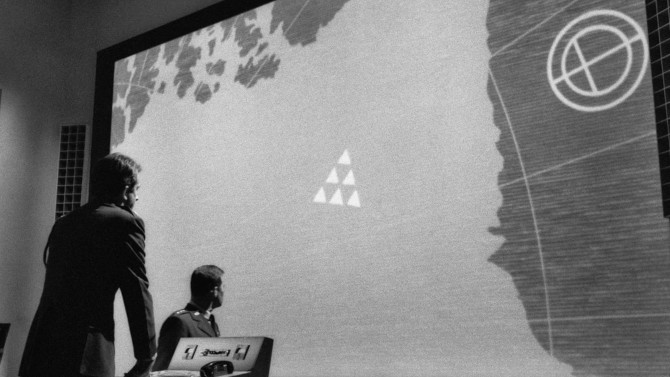
Safety First
Like a severe and utterly serious version of Stanley Kubrick’s 1964 satirical dark comedy Dr. Strangelove or: How I Learned to Stop Worrying and Love the Bomb, you would think that Fail Safe would have been the original release in theatres that was then later spoofed, yet that is not the case. Released approximately six months later in the same year, as you might imagine, it led to very poor returns at the box office – dare I say it (as the film deals with this subject matter)... it was a bomb! Despite that, over time, it has become a bonafide classic. Based upon Eugene Burdick’s 1962 novel of the same name and directed by Sidney Lumet (Dog Day Afternoon), he introduces us to our main players by way of little vignettes.
-

Easy Street?
Side StreetNovember 13, 2024Looking for the easy way out... it’s often a motif of the film noir. Taking the idea to its seemingly inevitable conclusion, director Anthony Mann (Desperate) definitely drives the concept down what seems to be every Side Street (1949) in The Big Apple in this tale of go on, take the money and run. Joe Norson (Farley Granger) is anticipating the birth of his first child with wife Ellen Norson (Cathy O’Donnell). The acting pair grace the screen together for the second and final time following They Live by Night from the previous year... funnily enough, it almost plays as a ‘what could have been’ second chance for that couple.
-

Amateur Dick
Cry DangerNovember 4, 2024If jailed for false pretenses, when you finally get out of prison, what would you do? The premise of the engaging film noir thriller Cry Danger (1951), made by former child star and first time director Robert Parrish (it is also said Dick Powell was quite involved in the film’s directing), one thing’s for sure, it’s about as hard boiled as you can get. Dick Powell (Murder, My Sweet) plays understandably rough around the edges Rocky Mulloy – a man who was falsely fingered in an armed robbery case that led to a murder.
-

Voodoo, and Zombies, and Ghosts, Oh My
The Ghost BreakersOctober 31, 2024Beating the famed comedy duo of Abbott and Costello to the horror comedy circuit both one and two years prior to their 1941 classic Hold That Ghost, Bob Hope released The Cat and the Canary in 1939, following it up in quick succession (just eight months later) with The Ghost Breakers in 1940 – it was originally a play written by Paul Dickey and Charles W. Goddard (there are also two silent films from 1914 and 1922 based on it that are thought to be lost – the former being directed by Cecil B. DeMille). Directed by George Marshall, the mystery infused horror comedy follows a socialite, Mary Carter (Paulette Goddard), who has learned on a stormy New York night that she has inherited a supposedly haunted castle on a secluded Cuban isle ominously named Black.
-
Off Pat
 PatrickPatrick Still LivesOctober 15, 2024
PatrickPatrick Still LivesOctober 15, 2024Though only coming out some seven years into the growing number of low budget Australian exploitation pictures being made – now known as Ozploitation, Patrick (1978) was one of the first to bring outside attention onto these Down Under flicks. A bomb in its homeland but gaining traction in thirty foreign markets (including its all important success in the United States), this Richard Franklin (Psycho II) venture helped put Ozploitation on the map... something fully achieved the next year when Mad Max burst onto the scene.
-

Masquerade Charade
The Kiss of the VampireOctober 11, 2024It’s just never a good sign when you’re honeymooning in the early 20th century Bavarian countryside and your brand new automobile runs out of petrol. The opening of a rather lesser known Hammer horror film (following a little bit of early staking action), The Kiss of the Vampire (1963), directed by Don Sharp, is shockingly without stalwarts Christopher Lee or Peter Cushing. The couple: Gerald (Edward de Souza) and Marianne (Jennifer Daniel), are left with little option. With the former walking ahead hoping for some aid, the latter is soon scared by a storm, bumping into the rather inimical Professor Zimmer (Clifford Evans)... coming across more like a morose vagabond than a learned man. All the while, a man from a hilltop manor, Dr. Ravna (Noel Willman), looks on with intrigue with the use of his telescope.
-

On Your Toes
SuspiriaSeptember 23, 2024Alfred Hitchcock: “When we tell a story in cinema we should resort to dialogue only when it's impossible to do otherwise. I always try to tell a story in the cinematic way, through a succession of shots and bits of film in between.” It is quite clear that Dario Argento took this quote from the Master of Suspense, Alfred Hitchcock, to heart when co-writing and directing his 1977 horror film Suspiria. An atmospheric mood piece, for much of its runtime, it plays as close to a silent film as you can get.

